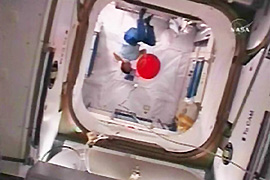Shuttle home after marathon mission
Endeavour lands in Florida after 10m km mission to international space station.

The orbiter glided in to land in darkness at 2039 local time after an earlier landing attempt was cancelled by heavy cloud cover.
That meant Endeavour had to take another orbit around the planet – the shuttle equivalent of driving once more around the block – before being cleared to land.
The mission, known as STS-123, installed the first part of Japan‘s Kibo space laboratory on the ISS and a Canadian-built robot arm intended to assist with maintenance of the $100bn orbiting outpost.
Shortly after landing Dominic Gorie, Endeavour’s commander, praised what he said had been a “super rewarding mission, exciting from the start to the ending.”
Endeavour’s visit to the ISS has given Japan its first foothold on the space station after billions of dollars of investment in the project.
| Kibo: Japan’s space lab |
|
Japan‘s first permanent manned presence in space
To be delivered into orbit by three shuttle flights
Scheduled completion in May 2008
Will conduct experiments on effect of microgravity
Includes platform with robotic arm to expose experiments to space |
When finished the micro-gravity research lab will be the station’s biggest single module.
Endeavour’s latest mission saw it spend 12 days docked to the ISS, the longest time any shuttle has spent at the station, with its crew conducting five spacewalks.
Returning with the shuttle were Japanese astronaut Takao Doi, who oversaw the installation of the first part of Kibo, and the European Space Agency’s French astronaut Leopold Eyharts, who was returning from a 50-day stint on the ISS.
Nasa has just 11 more shuttle flights before the its fleet of three ageing shuttles is retired from service in 2010.
One mission will be used to service the Hubble space telescope, while the rest will be devoted to completing construction work on the ISS.
After 2010 the US will have no manned space flight capability until the next generation Orion space craft comes into service – currently expected in 2014.
In the interim Nasa will have to rely on Russian Soyuz spacecraft to ferry crews to and from the ISS.
That has sparked criticism from several politicians who say the delay puts the US at risk of losing its leading place in space to newcomers like China.
